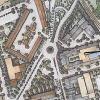What We Should Do With the Old Jittery Joe's Roaster Building
Downtown Master Plan

This is the 10th installment in a series of articles by University of Georgia College of Environment and Design professor Jack Crowley. In this series, Crowley explains the downtown Athens master plan that his team has generated to guide development downtown.
A number of columns have been written about some of the major ideas in the Downtown Athens Master Plan. Now we’ll look at the individual sites with the idea of what if this or what if that were done. What if a developer and the city got together to accomplish something on a particular site? The simple “what if?” question will possibly be a way to help the reader easily see a downtown idea that the plan recommends and maybe get excited about it.

The first installment looks at saving the iconic former Jittery Joe’s Roasting Co. building on East Broad Street. It was in the development path of the first Selig Proposal and was to be dismantled and scattered throughout various Athens coffee houses. In the new Landmark/Selig proposal, the building is not yet in jeopardy, but now is a good time to think and plan for an alternative for the building.
• The Athens-Clarke County government owns the land directly across East Broad Street and uses it only for a stormwater management site.
• The roasters building is privately owned, and moving it is roughly estimated to cost $50,000–$70,000. The public, the building’s owner or another private developer could move the structure out of its hole to a land-lease across the street.
• The reinforced floor of the relocated and renovated building would be at grade with the sidewalk along Hickory Street, where entrances to a number of shops or stores in the structure could face.
• The east side of the building could have sheltered decks to overlook the future Firefly Trail that would be extended northward through this stormwater park.
• If the public purchased and moved the building, it could then lease space to tenants.
• If the private sector moved and renovated the building, the relationship might be a master land-lease that is based on a small percentage of the rent collected by the private developer.
• Rents that are collected could be earmarked for the development and maintenance of the bicycle corridor and park.
• Tenants attracted to a site like this could include a coffee shop, deli or sandwich shop; a small bicycle sales, rental and repair business; a restaurant, a pub or artists’ studios.
• There are plenty of very nice urban park examples that also serve stormwater management purposes. Glenwood Park in Atlanta and the Atlanta BeltLine’s Fourth Ward come to mind.
• This is a small project. It can be done in phases. It can easily involve a public-private partnership that would get good things done, and it creates an open-space gathering area for the downtown’s east end while preserving a historic building.
Keywords
More by Jack Crowley
-

How to Fix Up the Costa Building
Downtown Master Plan
-

What Downtown Development Should Look Like
News Feature
-

Like It or Not, People Will Drive Downtown, and We Have to Deal With It
Part 8 on the Downtown Master Plan









comments